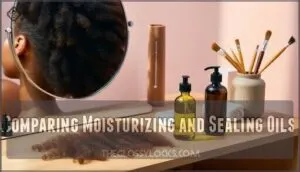This site is supported by our readers. We may earn a commission, at no cost to you, if you purchase through links.

That’s where sealants come in. These oils, butters, and serums don’t hydrate your hair—they trap the hydration you’ve already put there. Think of them as the lid on your water bottle, keeping everything inside from evaporating into thin air. Without a proper sealant, you’re pouring effort and product into a leaky bucket. With the right one, you’re locking down moisture for days instead of hours.
The difference between dry, brittle hair and strands that stay soft comes down to one step most people skip. Here’s what you need to know about choosing and using sealants that actually work for your hair type.
Table Of Contents
- Key Takeaways
- What is a Hair Sealant?
- Key Benefits of Using Hair Sealants
- Types of Hair Sealants Explained
- Choosing The Right Sealant for Your Hair
- How to Apply Hair Sealants Correctly
- Comparing Moisturizing and Sealing Oils
- Top Natural Oils and Butters for Sealing
- Common Mistakes to Avoid When Sealing
- Hair Sealant Trends and Market Insights
- Frequently Asked Questions (FAQs)
- How often should I use a sealant for my hair?
- Does using a sealant on my hair damage it?
- How long does a sealant last for?
- Does using a sealant make my hair look greasy?
- Can you use hair sealant on color-treated hair?
- How often should you apply hair sealants weekly?
- Do hair sealants protect against heat styling damage?
- Can sealants help with split ends or repair?
- Whats the shelf life of natural oil sealants?
- Conclusion
Key Takeaways
- Hair sealants trap moisture in your hair by forming a protective barrier after applying water or a leave-in product.
- Choosing the right sealant—whether oil, butter, or serum—depends on your hair type, porosity, and desired level of hydration.
- Correct application means sealing damp, moisturized hair in sections, not dry strands, to prevent frizz and breakage.
- Regular use of sealants not only keeps hair hydrated longer but also strengthens strands and reduces damage from daily stressors.
What is a Hair Sealant?
A hair sealant locks moisture into your hair strands after you’ve applied water or a leave-in product. Think of it as creating a protective barrier that keeps hydration from escaping and frizz from taking over.
So, what exactly are hair sealants, how do they work, and what types are out there? Let’s dive in and find out.
Definition of Hair Sealants
A hair sealant does exactly what it sounds like—it protects your hair by locking in moisture, just like a lid seals a jar.
These products, usually oils, butters, or serums, form a barrier on your hair’s surface to prevent water loss and keep your strands hydrated for longer.
Once you’ve used a water-based leave-in, sealants help lock in that moisture, keeping your hair safe from dryness, frizz, and breakage for much longer.
How Hair Sealants Work
Think of sealants as your hair’s personal bodyguard—they form a protective shield around each strand, trapping in moisture and blocking out humidity that causes frizz.
This works by smoothing down the hair cuticle, which naturally opens when wet. Sealing oils coat this layer, locking in hydration and preventing water from escaping too quickly.
The result? Lasting moisture and less frizz.
Common Forms (Oils, Butters, Serums)
Sealants come in three main textures, each with its own weight and feel on your hair—oils are the most popular, butters bring extra richness, and serums offer a sleek, modern twist.
Natural oils like jojoba and avocado provide lightweight moisturizing without buildup. Butters such as shea deliver deeper conditioning for thicker textures.
Hair serums blend modern formulas with heat-activated sealant technology, offering frizz control and shine. Choose based on your hair’s density and what it craves most.
Key Benefits of Using Hair Sealants
Hair sealants aren’t just about locking in moisture—they’re your first line of defense against the daily wear and tear that leaves hair dull, brittle, and unmanageable.
When you understand what sealants can actually do for your strands, you’ll see why they’ve become non-negotiable in so many hair care routines.
Let’s break down the top three reasons why sealants deserve a spot in your hair care routine.
Moisture Retention
Your hair can soak up all the water in the world, but without a sealant, it’s like trying to hold water in your bare hands—within hours, that moisture slips right through.
Sealants lock in hydration by creating a protective barrier on each strand, boosting water retention no matter your hair porosity.
This moisture balance is key to managing humidity’s effects, keeping your strands properly hydrated between washes instead of leaving them dry and brittle.
Frizz Control and Smoothing
When frizz takes over, it’s not just about bad weather—it’s often because your hair cuticle is rough, raised, and desperately reaching out for moisture it’s already lost.
Sealants act as frizz fighters by coating each strand with a smooth barrier that discourages humidity from disrupting your style.
These smoothing techniques with oils or serums transform unruly texture into hair silkening results, giving you frizz reduction and smooth styling that lasts all day without constant touch-ups.
Strengthening and Breakage Reduction
Breakage is the silent thief that slowly robs you of length, no matter how patient you’re with your growth journey. Sealants provide hair fortification by creating a protective shield that locks in the moisture your strands need for strand strengthening and fracture reduction.
When you apply hair sealing techniques correctly, you’re actively supporting breakage prevention through:
- Damage repair from environmental stressors and daily manipulation
- Reducing hair breakage at weak points along the shaft
- Hair growth promotion by protecting ends from splitting and snapping
This hair protection approach gives you real control over your length retention.
Types of Hair Sealants Explained
Hair sealants come in three main categories, each with its own texture and application style. You’ll find natural oils that absorb quickly, rich plant butters that provide heavier protection, and commercial formulas designed for specific results.
Let’s break down what each type offers so you can figure out which one works best for your hair.
Natural Oils (Olive, Jojoba, Castor, Avocado)
Natural oils are the unsung heroes of hair sealing, each with its own unique way of locking in moisture for healthy, hydrated strands.
Olive oil provides intense hydration and fights dryness thanks to its rich fatty acids. Jojoba oil mimics your scalp’s natural sebum, making it perfect for moisture retention and promoting hair growth. Jamaican Black Castor Oil offers intensive therapy that stimulates growth while sealing in moisture. Avocado oil creates a protective barrier for excellent moisture retention and breakage prevention.
| Natural Oil | Primary Benefit | Best For |
|---|---|---|
| Extra Virgin Olive Oil | Fights dryness, reduces hair loss | All hair types needing deep moisture |
| Jojoba Oil | Mimics natural sebum, retains moisture | Normal to dry hair, scalp health |
| Jamaican Black Castor Oil | Stimulates growth, locks in hydration | Thin or damaged hair needing repair |
| Avocado Oil | Forms protective barrier, reduces breakage | Brittle, breaking hair |
Plant Butters (Shea, Mango)
Plant butters add a thick, luxurious richness to hair sealing, acting like a protective shield that coats each strand in deep moisture. Shea butter provides vitamins and fatty acids that keep hair hydrated for days, while mango butter offers lighter nourishment without weighing it down.
You can mix these natural moisturizers to create tailored hair care solutions that directly address dryness. They’re ideal for natural hair routines when you need serious, long-lasting moisture.
Commercial Sealant Products
Commercial sealant products bring salon-quality results right to your bathroom, combining scientifically proven ingredients with the ease you need for a smooth, frizz-free look. For example, Liquid Glass Miracle Smoothing Sealant uses heat-activated formulas with vegan keratin and burdock root to keep frizz at bay.
When checking out sealant formulas, look for smoothing complexes that coat each strand without using petroleum or mineral oil. Brand comparisons show how ingredient analysis and market trends now lean toward these modern hair sealing solutions.
Choosing The Right Sealant for Your Hair
Not all sealants work the same way on every head of hair. Your hair type, porosity level, and texture all play a role in determining which products will lock in moisture without weighing you down or leaving buildup.
Here’s what you need to know to match the right sealant to your specific needs.
Hair Type Considerations
Your hair type isn’t just a category—it’s the roadmap that tells you which sealant will lock in moisture without leaving your strands weighed down or parched.
Fine hair thrives with lightweight oils like grapeseed, while curly hair and natural hair textures benefit from richer butters that tackle dry hair and porous locks.
Damaged ends need extra protection, so heavier sealants improve hair hydration without sacrificing hair moisture retention during your hair sealing routine.
Hair Porosity and Sealant Selection
Understanding porosity—how easily your hair absorbs and holds onto moisture—changes everything about which sealant actually works.
Low porosity hair has tight cuticles that repel heavy oils, so lightweight options like grapeseed work best.
High porosity hair drinks up moisture fast but loses it just as quickly, demanding thicker sealants like shea butter to trap hydration inside those raised cuticles and maintain moisture levels.
Lightweight Vs. Heavy Sealants
The weight of your sealant matters just as much as your porosity—pick the wrong one, and you’ll either starve your strands or smother them completely.
The texture and thickness of your oil or sealant are what really determine how well they’ll work for your hair.
- Lightweight oils (grapeseed, argan) absorb fast without product buildup—ideal for fine hair density
- Medium-weight options (jojoba, sweet almond) balance moisture retention across most hair types
- Heavy sealants (castor oil, shea butter) lock moisture levels deep but can overwhelm thin strands
- Sealing oils applied after leave-in products trap hydration where cuticles need it most
- Oil benefits for hair depend on matching texture to your hair’s actual moisture-holding capacity, not trends
Hair moisturizing success hinges on this weight equation.
How to Apply Hair Sealants Correctly
Applying a hair sealant the right way makes all the difference in how long your moisture stays locked in. The technique matters just as much as the product you choose.
Here’s how to seal your hair correctly, from the basic steps to timing it with your wash routine.
Step-by-Step Sealing Process
Sealing your hair properly comes down to three simple moves: start with damp strands, layer your moisture first, then lock it all in with your chosen oil or butter.
Work section by section, applying your sealing oils from mid-shaft to ends where moisture retention matters most.
Understanding your hair porosity helps you determine how much product application you need—high-porosity hair drinks up sealants, while low-porosity strands need lighter layers to avoid buildup.
The L.O.C. Method Explained
Once you’ve locked in your sealing routine, the L.O.C. method makes it easy to layer your products in the best order: start with liquid, add oil, then finish with cream.
Start with a water-based leave-in to hydrate, follow with your sealing oils to trap that moisture, and finish with a cream to lock everything down.
This hair layering technique works especially well for natural hair care because each layer builds on the last, creating a moisture-locking system that keeps your strands protected and hydrated between wash days.
When to Seal (e.g., Wash Day)
Timing your sealing routine right can make or break your moisture retention. Wash day is when your hair is primed to absorb and hold every drop.
Fresh from the shower, your strands are saturated with water, creating the ideal foundation for your hair care routine. Apply your leave-in while hair is still damp, then layer your sealant immediately to trap those moisture levels before they evaporate.
For high-porosity hair, sealing frequency matters—don’t wait until your hair dries out.
Comparing Moisturizing and Sealing Oils
Not all oils work the same way in your hair care routine. Some penetrate the strand to add moisture, while others sit on top to lock that moisture in.
Understanding the difference between moisturizing oils and sealing oils—and when to reach for each—will help you build a routine that actually works for your hair.
Moisturizing Oils Vs. Sealing Oils
Not all oils play the same role in your hair care routine. Some act like a drink of water for your strands, while others work more like a protective lock to keep that moisture from escaping.
Moisturizing oils have a lighter viscosity and penetrate the hair cuticle to deliver hydration directly into your strands.
Sealing oils form moisture barriers on the surface, protecting what’s already there and supporting scalp health by reducing water loss.
When to Use Each Type
Knowing which oil to reach for depends on where your hair is in its moisture cycle—and what it needs most in that moment. Use moisturizing oils like coconut or argan after cleansing when your hair is thirsty and porous.
Follow with sealing oils—jojoba, castor, or grapeseed—after applying a leave-in to lock hydration in. Daily sealing works for drier textures, while seasonal adjustments help you respond to shifting humidity and temperature.
Popular Oils for Each Purpose
When it comes to hair oils, some work to hydrate your strands, while others are all about locking that moisture in.
Take moisturizing oils like coconut and argan oil—they sink in deep to nourish your hair from the inside out.
Sealing oils—jojoba oil, grapeseed, and castor—sit on the surface to lock in moisture and control frizz. Jojoba oil mimics your scalp’s natural sebum, while castor oil promotes hair growth.
Each sealant type offers unique benefits, so matching them to your routine can make a big difference.
Top Natural Oils and Butters for Sealing
Now that you understand the difference between moisturizing and sealing, let’s look at the best natural options to lock in that moisture.
The right sealant depends on your hair type and what you’re trying to achieve. Here are six powerhouse oils and butters that work exceptionally well for sealing.
Jojoba Oil
Jojoba oil acts like a natural copycat of your scalp’s sebum, which is why your hair absorbs it so easily as a moisture-locking shield. This lightweight sealing oil won’t weigh down your strands, making it ideal for blending with heavier oils when you need tailored moisture protection.
Key benefits of jojoba oil for sealing:
- Keeps scalp healthy by balancing oil production without clogging follicles
- Encourages hair growth by creating a healthy environment for stronger strands
- Works well with most hair care products in your moisturizing routine
- Excels in hair moisturizing techniques like the L.O.C. method
- Blends the benefits of moisturizing and sealing oils effectively
Sweet Almond Oil
Sweet almond oil smooths the hair shaft, much like a finishing coat on fine wood. It strengthens strands while locking in much-needed moisture.
Packed with vitamin E and fatty acids, this oil boosts nutrient absorption during scalp massages. It blends well with other oils and works great in hair moisturizing routines, making it a handy addition to your hair care regimen.
Plus, it naturally encourages hair growth.
Avocado Oil
Avocado oil brings something extra to the table—it’s a barrier-builder that doesn’t just sit on your strands but actively protects them from moisture loss.
This oil is rich in vitamins A, D, and E, plus monounsaturated fats that penetrate the hair shaft deeply. Its nutrient profile boosts hair growth while reducing breakage, making it a solid choice for strengthening fragile ends.
Use avocado oil as a sealing oil to lock in hydration after applying your leave-in conditioner.
Grapeseed Oil
If you’re working with fine or easily weighed-down hair, grapeseed oil is your lightweight champion that seals without the heaviness.
This oil extraction from grape seeds softens rough hair cuticles and strengthens weak strands without leaving residue.
Its high linoleic acid content makes it one of the best lightweight sealants for moisturizing oils—perfect in grapeseed recipes for hair care when you want sealing oils that won’t compromise volume.
Shea and Mango Butter
For thicker hair types or deep moisture needs, shea and mango butter step up as rich, creamy sealants that pack serious hydration power. Both butters provide vitamins and fatty acids that keep hair hydrated long after your wash day. You’ll find they work beautifully in butter blends or as a leave-in treatment when your strands need extra nourishment.
Key butter benefits for hair care:
- Shea butter forms a protective barrier that locks moisture deep into your hair shaft
- Mango butter melts easily into strands, delivering lightweight hydration without greasiness
- Both natural moisturizers excel at moisturizing and styling in one step
- Perfect for sealing after water-based products in your hair hydration routine
Jamaican Black Castor Oil
When you want a powerhouse oil that pulls double duty—stimulating growth while locking down moisture—Jamaican Black Castor Oil becomes your go-to. This thick, dark oil comes from traditional roasting methods that preserve nutrients your scalp craves. Use it in your LOC method as the final sealing step, or warm it between your palms for scalp massage techniques that boost circulation and encourage healthier growth.
| Castor Oil Benefits | Application Method | Best Used For |
|---|---|---|
| Locks in deep moisture | Seal damp hair after leave-in | Thick, coarse textures |
| Stimulates hair growth | Warm scalp massage | Thinning areas |
| Strengthens weak strands | Mix with lighter sealing oils | Breakage-prone hair |
| Reduces scalp inflammation | Direct application to scalp | Dry, flaky conditions |
Common Mistakes to Avoid When Sealing
Even experienced hair care enthusiasts can trip up when sealing moisture into their strands. The difference between healthy, hydrated hair and greasy, product-laden locks often comes down to avoiding a few key missteps.
Here’s how to sidestep the most common sealing mistakes, so your hair stays nourished—never heavy.
Applying on Dry Hair
Skipping the moisture step and slapping sealant on dry hair is like trying to lock an empty safe—you’re sealing in nothing but disappointment. Your hair needs water or a leave-in product first to give sealing oils something to hold onto. Without that foundation, you’ll just coat dry ends with oil, which won’t fix frizz or restore smoothness.
Here’s what actually happens if you try to seal dry hair:
- You’re wasting product – Sealing oils can’t generate moisture, only preserve what’s already there
- Frizz resistance becomes impossible – Dry cuticles stay raised and rough, no matter how much oil you apply
- Your hair care routine falls apart – Proper sealant layering requires hair rehydration before treatment
Overusing Heavy Oils
Too much of a good thing turns your carefully planned hair routine into a greasy mess that weighs down every strand. Heavy sealing oils like Jamaican Black Castor Oil work best in small amounts—overdoing it creates oil buildup that leave-in products can’t penetrate.
You’ll end up with limp, greasy hair that refuses to hold any style, no matter how well you balance your oil application.
Mixing With Mineral Oil or Petroleum
Petroleum-based products form a watertight seal that keeps moisture out rather than in—completely defeating the purpose of your sealing routine. Mineral oil can block water absorption and stop moisturizing oils from nourishing your strands.
Instead, opt for petroleum alternatives like jojoba or avocado oil for effective hair protection and styling. These sealing oils work seamlessly with your hair care routine.
Hair Sealant Trends and Market Insights
The hair sealant market is growing fast, driven by consumers who want stronger, healthier hair that holds moisture better.
Clinical studies back up what stylists have known for years—sealants work. Here’s what the numbers and research tell us about where this category is headed.
Market Growth and Consumer Demand
The global hair care market is seeing strong growth, fueled by rising consumer interest in hair smoothing and frizz control products. The hair serum segment was valued at $1.27 billion in 2024 and is expected to grow over 5.8% annually through 2034.
Now more than ever, your hair care routines have access to a wider range of effective sealant options. Consumer trends show a growing focus on products that promote hair growth and prevent damage, especially since over 40% of women experience noticeable hair loss by age 40.
Regional trends indicate that Europe and Asia Pacific are leading the market, with online retail becoming the fastest-growing distribution channel for these protective products. The haircare industry is driven by the increasing demand for hair care products that address various hair concerns.
Clinical Evidence for Sealant Benefits
Stop playing the guessing game with your hair—there’s real science behind the power of sealants. Studies have shown that when you use hair sealants regularly, you can actually see real, measurable improvements in your hair’s health.
- Hair Density increased by nearly 8% after 90 days of daily serum application
- Breakage Prevention improved by up to 88% with silicone conditioning agents in sealants
- Frizz Reduction achieved through smoother cuticles, with coconut oil reducing irregularity by 65%
- Moisture Lock retained up to 72% effectiveness even after 12 months of regular use
- Over 98% of participants experienced effective control of Hair Growth concerns with zero adverse reactions
These findings confirm that Sealing Oils and Moisturizing Oils aren’t just about shine—they’re backed by science for stronger, healthier strands. Understanding the benefits of hair oil sealants is key for achieving the best results in hair care.
Popular Products and Ingredients
You’re seeing a shift toward cleaner, science-backed sealant ingredients in 2025. Hyaluronic acid now appears in 83% of new leave-in products, while ceramides reinforce cuticle sealing in bestsellers like Gisou Honey Gloss Mask.
Argan oil, Jamaican Black Castor Oil, and jojoba remain top choices in product reviews, with 67% of consumers preferring natural butters and hair oils over synthetics.
Market trends show fragrance-free options grew 22%, and male-focused sealants expanded rapidly—proof that moisturizing oils aren’t just trending, they’re evolving.
Frequently Asked Questions (FAQs)
How often should I use a sealant for my hair?
Seal your hair each wash day—usually once or twice a week, depending on your hair type and care routine.
Apply sealing oils after moisturizing for effective natural hair maintenance and healthy growth.
Does using a sealant on my hair damage it?
No—when you use the right sealant for your hair type and apply it correctly, damage prevention is the goal.
Hair damage risks come from sealant overuse or product buildup, not from sealing itself.
How long does a sealant last for?
Good things take time, and your hair knows it. Sealant Longevity depends on Hair Type Factors like porosity and texture.
Most Sealing Oils need Reapplication Frequency of two to four days between Hair Care sessions.
Leave-in products boost Sealant Durability, supporting Hair Growth and Care through consistent Moisturizing Oils use.
Does using a sealant make my hair look greasy?
Not if you apply the right amount. Overdoing sealing oils or using heavy products on fine hair can lead to product buildup and a greasy appearance.
Lightweight options like grapeseed oil help maintain frizz resistance without excess oil absorption.
Can you use hair sealant on color-treated hair?
Yes, sealants are safe for color-treated hair. Natural oils like jojoba and avocado oil protect your color while locking in moisture.
They help prevent fading and repair damage by strengthening treated strands, keeping your hair healthy and hydrated without stripping the color.
How often should you apply hair sealants weekly?
Most people benefit from sealing their hair two to three times a week, aligning with their wash and moisturizing routines.
The ideal frequency depends on your hair type and porosity—fine hair needs lighter, less frequent application, while thicker hair can handle more regular sealing with oils and leave-in products for best results and hydration.
Do hair sealants protect against heat styling damage?
As the saying goes, “an ounce of prevention is worth a pound of cure.” Certain hair sealants offer heat protection by forming a thermal shield, helping reduce styling damage, frizz, and breakage—especially when paired with heat-activated hair smoothing products.
Can sealants help with split ends or repair?
Split End Repair starts with consistent care. While sealants can’t fuse split ends back together, they lock in moisture and help with Damage Control, Frizz Reduction, and Hair Breakage—preserving Hair Health and Hydration between trims.
Whats the shelf life of natural oil sealants?
Open that bottle, and you might not realize that Jamaican Black Castor Oil, Coconut Oil, or Argan Oil can last 12-24 months—if you store them tightly closed, cool, and away from sunlight to prevent rancidity.
Conclusion
Like water that quenches thirst but slips through open fingers, moisture escapes hair without a reliable sealant. By understanding your hair type, selecting the right formula, and mastering application methods, you turn a fleeting softness into lasting hydration.
Choosing the right sealant for hair is no extra step—it’s the foundation for strong, manageable strands, less frizz, and lasting shine. Take control, protect your efforts, and let your healthiest hair finally stay within reach.
- https://www.gminsights.com/industry-analysis/hair-serum-market
- https://www.grandviewresearch.com/industry-analysis/hairstyling-products-market-report
- https://www.prnewswire.com/news-releases/hair-care-market-size-is-set-to-grow-by-usd-15-25-biilion-from-2024-2028--influence-through-social-media-and-blogging-boost-the-market-technavio-302200517.html
- https://www.americansalon.com/hair/7-hot-trends-us-hair-care-market
- https://clinicaltrials.gov/study/NCT07195487













